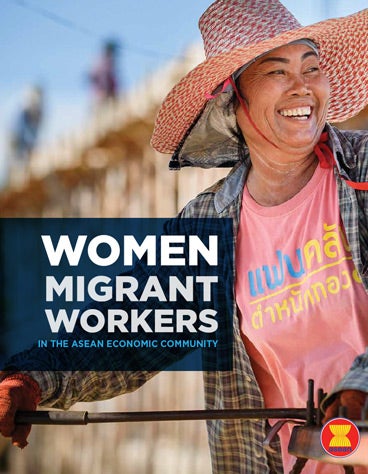
Women Migrant Workers in the Asean Economic Community

The ASEAN Economic Community (AEC) was formally established in December 2015. It is expected that the AEC will boost regional economies by 7.1 per cent and create almost 14 million new jobs. Free movement of skilled labour, which takes into account relevant domestic regulations and market demand conditions, is a key component of this regional economic integration agenda. ASEAN main destination countries – Brunei Darussalam, Malaysia and Singapore – have already experienced large labour mobility flows and a high reliance of several industries on migrant workers. Currently, the total stock of international migrants in the ASEAN is 9.9 million and of those, nearly 6.9 million have moved between countries within the region. Furthermore, according to recent research, the share of migrant workers is expected to rise with the regional integration of labour markets. To facilitate the governance of labour flows and ensure the successful economic integration of migrant workers in ASEAN, a plethora of regional frameworks, coordination mechanisms and national policy initiatives have been devised, setting ASEAN at the forefront of the international governance of labour mobility.
A substantive contribution towards the region’s labour markets, production and remittance flows is made by women and girls who account for nearly half (48.7 per cent) of the intra-ASEAN migrant working age population. Yet a growing body of research has raised concerns about intersecting gender, age, ethnicity and legal status vulnerabilities impacting access to rights and opportunities for women and girls at different stages of the migration journey as well as about disparities in access to employment, income and social protection. Intrinsically, a fair question to ask is whether ASEAN’s women and girls migrant workers, who are often employed in low-skill professions, will benefit from the expected increasing mobility and job opportunities in their own region.
The overall aim of this study is to shed new light on intra-ASEAN migrant women’s labour mobility trends, access to and outcomes in labour markets, the contribution to ASEAN economies and high-growth sectors, and the challenges of social and economic inclusion. The report also reviews the current migrant governance frameworks at national and regional level, providing actionable evidence-based policy recommendations to benefit from women’s labour mobility, provide fair and equitable migration opportunities for women, and enhance regional social and economic development.
View online/download
Bibliographic information
Related news
Featured Infographics

Will women workers fully benefit from increasing job opportunities and mobility in Southeast Asia?
Infographics explain the current situations of migrant workers and the governance frameworks at national and regional level, providing actionable evidence-based policy recommendations to benefit from women’s labour mobility, provide fair and equitable migration opportunities for women, and enhance regional social and economic development... Read more